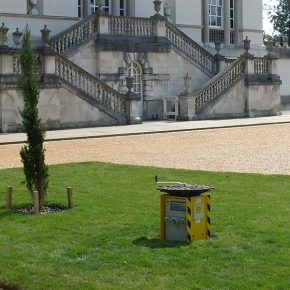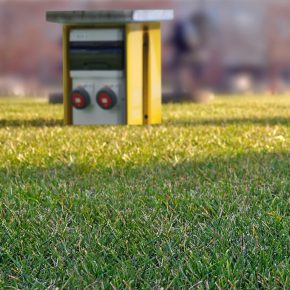
Pop Up Power: Making outdoor spaces more versatile without ruining visual appeal
Installing an outdoor power supply can transform a site’s potential and usability, but it has to be done without compromising aesthetics, explains Pop Up Power Supplies…
Many of the UK’s most popular tourist destinations draw visitors from around the world because of their combination of unique sights, history, architecture and landscaping plus activities during the visit.
This combination requires spaces to be planned and managed in a way that allows events and other outdoor facilities to be provided whilst retaining the main factor in the attraction’s appeal – how it looks.
One of the reasons why parks, courtyards, pedestrianised streets and plazas can lose their attraction is when they become cluttered with signage, lampposts and other street furniture.

So, any strategy to make these kinds of outdoor spaces more practical with, for example, performance areas and food and drink stalls, should avoid adding more clutter.
The key to adding functionality is to install a power infrastructure but with that comes risk. Unfortunately, standard feeder pillars, cordoned-off generators and lengthy cables trailing on the ground, even when covered by cable protectors, will do nothing to protect the visual appeal of a tourist attraction, regardless of whether it is a heritage site or a new/redeveloped urban location like Liverpool’s waterfront or Canary Wharf.
Power connectivity that’s only visible when you need it
When you consider iconic British landmarks like Tower Bridge or Edinburgh Castle, nobody would want to see the spaces around them poorly landscaped or cluttered. But that is what can happen when temporary events are held or set-up unless the site has the right power infrastructure.
Preparing an outdoor site properly for temporary events – even in the most sensitive locations – can be done through the installation of retractable (pop-up) or in-ground units. These are permanently installed in the ground, submerged beneath the surface, and accessed only when a power connection is required, such as for a market stall, food takeaway or stage/performance area.
The principle is simple – by keeping the units virtually hidden when they are not in use, there is no impact on how a landscape, garden or historic building looks externally. Yet the space will still have the flexibility to host the events that are so important to the attraction or site’s economic sustainability.
In-ground power unit or a pop up unit?
Within the range of power units available from UK company Pop Up Power Supplies are in-ground power units, which are accessed via a flip-lid, and retractable/pop up power units that you can raise from the ground when required. But which is best?
Pop Up Power Units provide an instant electrical feeder pillar in the middle of an outdoor space to give access to sockets close to where they are needed. The units are raised using a simple turning handle and lowered back into place when no longer needed.
The only thing visible when they are not in use is a small cover which looks similar to what you would see for other in-ground services. When an event is in-use, the unit is easy to access and raise into position and it is clearly visible to minimise the risk of anyone accidentally colliding with it.
An in-ground unit can be installed exactly where power is needed by it stays submerged. When an event is being set-up, authorised staff or event organisers simply unlock the unit’s flip lid and connect the power leads. The lid can then be locked down while the leads are still connected to allow for continuous unattended use – great from a public safety perspective.
Integrating a ‘power bollard’ into the street furniture suite
A third option from Pop Up Power Supplies, which is permanently visible yet designed to be a stylish feature rather than utilitarian, is the power bollard. These elegantly designed bollard come in four styles and any RAL colour finish, incorporate power sockets which are accessed via a hatch closure.
This allows power leads to be connected as and when they are required. And when no power is needed, the unit integrates with the rest of the street furniture keeping the power sockets safely out of sight and reach.
Top UK tourist attractions already benefitting from Pop Up Power Supplies units
Pop Up Power Units have been installed on the sites of some of the most popular tourist attractions in the UK over the past two decades, including:
– Edinburgh Castle
– The Sunken Garden at Kensington Palace
– The Cutty Sark, Greenwich
– Caerphilly Castle
– Chiswick House, London
Visit Supplier's page
Latest news

30th April 2025
Digital Construction Week announces seminar programme for its landmark 10th edition
Digital Construction Week (DCW) returns to ExCeL London on 4 – 5 June 2025 with its most impactful programme yet. It brings together the best and brightest from across AECO, for two days of practical learning and idea sharing.
Posted in Articles, Building Industry Events, Building Industry News, Building Products & Structures, Building Services, Building Systems, Exhibitions and Conferences, Information Technology, news, Restoration & Refurbishment, Retrofit & Renovation, Seminars
29th April 2025
Senior pledges to ‘bee’ part of the solution with new biodiversity initiative
Senior Architectural Systems has installed its first on-site beehive, marking another step forward in its commitment to sustainability and biodiversity.
Posted in Articles, Building Industry News, Building Products & Structures, Building Services, Curtain Walling, Doors, Glass, Glazing, Innovations & New Products, news, Restoration & Refurbishment, Retrofit & Renovation, Sustainability & Energy Efficiency, Walls, Windows
29th April 2025
West Fraser range delivering key benefits for South-East carpentry company
An experienced carpenter and building site manager who has recently set up his own company is using high performance panel products from the West Fraser range.
Posted in Articles, Building Industry News, Building Products & Structures, Building Systems, Case Studies, Garden, Restoration & Refurbishment, Retrofit & Renovation, Sustainability & Energy Efficiency, Timber Buildings and Timber Products
29th April 2025
CPD Courses Available Online From Ecological Building Systems
Ecological Building Systems, a leading supplier of natural building products for sustainable construction, has revealed its comprehensive CPD programme for the year ahead.
Posted in Articles, Building Industry Events, Building Industry News, Building Products & Structures, Building Services, Continuing Professional Development (CPD's), Information Technology, Innovations & New Products, Insulation, Restoration & Refurbishment, Retrofit & Renovation, Seminars, Sustainability & Energy Efficiency, Training, Walls, Waste Management & Recycling
 Sign up:
Sign up: